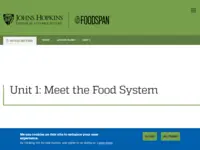https://foodspan.org/lesson-plans/unit-1-meet-the-food-system
John Hopkins Center for a Livable Future
This learning activity takes two 55 minute class periods.
Learn more about Teaching Climate Literacy and Energy Awareness»Grade Level
Online Readiness
Topics
Climate Literacy
This Activity builds on the following concepts of Climate Literacy.
Click a topic below for supporting information, teaching ideas, and sample activities.
Energy Literacy
This Activity builds on the following concepts of Energy Literacy.
Click a topic below for supporting information, teaching ideas, and sample activities.
Notes From Our Reviewers
The CLEAN collection is hand-picked and rigorously reviewed for scientific accuracy and classroom effectiveness.
Read what our review team had to say about this resource below or learn more about
how CLEAN reviews teaching materials
Teaching Tips | Science | Pedagogy |
Technical Details
Teaching Tips
- The different activities would help students with different learning styles.
- Consider having students read the primer before class as homework, or use in-class time to popcorn read these sections.
- If time allows, consider teaching the extensions listed in these two lessons- they will help broaden students' understanding of the topic.
About the Content
- This two-part resource from the Johns Hopkins center for a Livable Future provides students with an introduction to the food system by exploring the connections between resources in each step of the supply chain and the history of agriculture.
- In part A, students will use discussion, infographics, and a tangible activity to come up with their own ideas about the significance and relationships between food, health, and society.
- In part B, students explore the industrialization of agriculture through a timeline activity and short readings to learn key concepts like specialization and mechanization.
- This resource focuses largely on introducing key concepts to students, and educators should follow links for "Crops and Ecology" to bring attention to the ecological consequences of industrialized agriculture.
- The data is available digitally in visual summaries of a food system supply chain based on academic journal articles and university websites. Each slide has references to the photos and where the content came from.
- Passed initial science review - expert review pending.
About the Pedagogy
- This resource supports an introductory understanding of food systems through a variety of learning activities including discussion, a tangible group activity, a group presentation, and a classroom timeline activity.
- This variety is likely to engage a wide range of learners with different strengths and learning preferences.
- These two introductory lessons are followed by another 15 lessons in the curriculum. Lessons 1-9 focus on food production, harvest, and transport, and 10-15 focus on the social, economic, and cultural aspects of the food system.
- There is rich content in the full lesson set, and teachers are likely to find a lesson that suits their needs even if they don't teach the full lesson. This is a well organized resource with a great teaching sequence.
Technical Details/Ease of Use
- Easy to follow teachers guides with ready-to-use power points and print outs.
Related URLs These related sites were noted by our reviewers but have not been reviewed by CLEAN
- Find the full lesson set here. Lesson five focuses on climate change specifically.
- Find standards for this lesson here.








